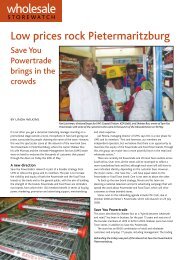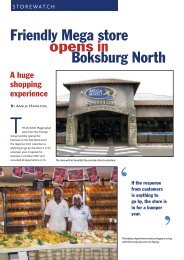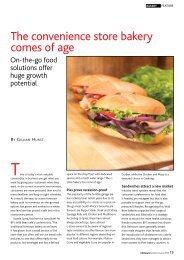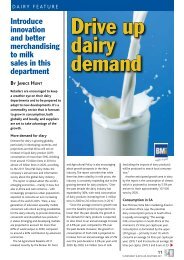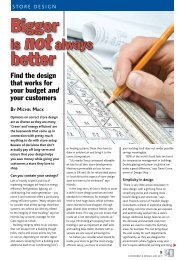The South African solution to supply chain - Supermarket.co.za
The South African solution to supply chain - Supermarket.co.za
The South African solution to supply chain - Supermarket.co.za
You also want an ePaper? Increase the reach of your titles
YUMPU automatically turns print PDFs into web optimized ePapers that Google loves.
Benefits from<br />
centralised<br />
distribution include<br />
better on-shelf<br />
availability, while<br />
at the same time<br />
holding lower overall<br />
inven<strong>to</strong>ry levels<br />
in s<strong>to</strong>res<br />
Just in time (JIT) delivery is a growing trend in retail <strong>to</strong> reduce inven<strong>to</strong>ry at s<strong>to</strong>re level.<br />
A lot of s<strong>to</strong>res are now built with more floor space and less backroom.<br />
SUPPLY CHAIN<br />
▲<br />
■ Unskilled, non-permanent<br />
labour force<br />
Many of the key personnel involved in<br />
critical <strong>supply</strong> <strong>chain</strong> processes are either<br />
casual labour or unskilled. “This leads <strong>to</strong><br />
unpredictable turnaround times, s<strong>to</strong>ck<br />
losses, damages, lack of ownership of<br />
process and security threats,” <strong>co</strong>mments<br />
Kelly. <strong>The</strong>se pressures are exacerbated<br />
further by the strong presence of trade<br />
unions and the resulting downtime thanks<br />
<strong>to</strong> the inevitable industrial action.<br />
■ Diverse physical<br />
operating environments<br />
“It is as though every receiving, dispatch,<br />
back-up area and processing zone has been<br />
designed and built differently,” he says.<br />
This adds <strong>co</strong>nfusion and restraints <strong>to</strong> the<br />
planning and delivery execution processes.<br />
For example, s<strong>to</strong>res located next <strong>to</strong> each<br />
other that are receiving a delivery on the<br />
same day may have <strong>to</strong> be planned on<br />
separate vehicles due <strong>to</strong> physical receiving<br />
<strong>co</strong>nstraints, adding <strong>to</strong> the <strong>co</strong>st of logistics.<br />
Centralised efficiencies<br />
In 2012, Pick n Pay opened its new<br />
distribution centre (DC) in Philippi, Cape<br />
Town – the se<strong>co</strong>nd of a planned four across<br />
the <strong>co</strong>untry.<br />
Commenting at the May launch,<br />
divisional direc<strong>to</strong>r of <strong>supply</strong> <strong>chain</strong>, Cobus<br />
Barnard said: “It will allow us <strong>to</strong> operate<br />
Most retailers began embracing centralised distribution years ago. However, not all vendors can<br />
go through a DC so there will always be a need for direct <strong>to</strong> s<strong>to</strong>re delivery (DSD), especially in<br />
provinces where retailers don’t have their own regional DCs.<br />
more <strong>co</strong>st effectively and improve our<br />
ability <strong>to</strong> serve our cus<strong>to</strong>mers at the same<br />
time. Benefits from centralised distribution<br />
include better on-shelf availability, while<br />
at the same time holding lower overall<br />
inven<strong>to</strong>ry levels in s<strong>to</strong>res. This means less<br />
<strong>co</strong>ngestion at our s<strong>to</strong>res’ receiving centres<br />
and importantly lower transport <strong>co</strong>sts in<br />
our <strong>supply</strong> <strong>chain</strong>.”<br />
Logtrix provides scheduling and <strong>supply</strong><br />
<strong>chain</strong> productivity services <strong>to</strong> Pick n Pay<br />
nationally across all divisions and has<br />
been integrally involved in the retailer’s<br />
direct s<strong>to</strong>re delivery (DSD) planning and<br />
operations over the past 24 years.<br />
Centralised distribution is also great from<br />
a delivery point of view for carriers as they<br />
have a single delivery point per region rather<br />
than having <strong>to</strong> send vehicles all around the<br />
<strong>co</strong>untry. “Also, vehicles make bookings so<br />
you don’t spend the entire day at a back<br />
door because of queues,” explains Aling.<br />
However, there are <strong>co</strong>st implications<br />
within the DC model. “Because retailers<br />
know that suppliers want <strong>to</strong> ship <strong>to</strong> DCs,<br />
they can charge DC allowances. But it<br />
definitely still makes e<strong>co</strong>nomic sense <strong>to</strong><br />
deliver bulk loads <strong>to</strong> the retailer DCs and<br />
let them <strong>co</strong>nsolidate their s<strong>to</strong>re orders and<br />
ship themselves,” he says.<br />
▲<br />
8<br />
SUPERMARKET & RETAILER, APRIL 2013




